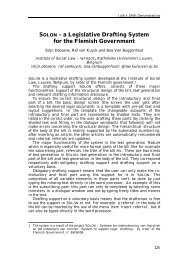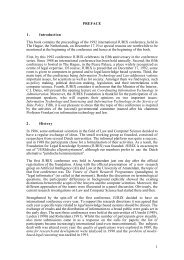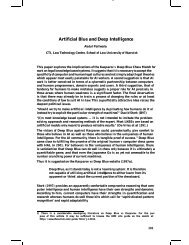On automatic causal reasoning for legal analysis - Jurix
On automatic causal reasoning for legal analysis - Jurix
On automatic causal reasoning for legal analysis - Jurix
You also want an ePaper? Increase the reach of your titles
YUMPU automatically turns print PDFs into web optimized ePapers that Google loves.
though, requires at least some knowledge of the existing philosophical and AI theories of<br />
causation. This is necessary in order to make the best choices we can, despite the present<br />
limitations in the representation of common sense. The next section presents a highly<br />
condensed overview of what philosophy and AI have to say on causation, with particular<br />
attention to the latest development in the latter field, i.e. Pearl’s approach.<br />
<br />
&DXVDWLRQLQ3KLORVRSK\DQGLQ$UWLILFLDO,QWHOOLJHQFH<br />
As far as philosophy is concerned, Section 2 on <strong>legal</strong> theory gives enough of an idea of what<br />
a philosophical dispute looks like: vague, prolix, metaphorical and confusing. If we had to try<br />
the same type of reconstruction <strong>for</strong> philosophical accounts of <strong>causal</strong> concepts, we would end<br />
up writing an article within the article. Instead we present here two lists: the list of problems<br />
and the list of the approaches. <strong>On</strong> the one hand, two thousands years of philosophy have<br />
produced a set of questions that any minimally complete theory of <strong>causal</strong>ity must answer.<br />
These questions concern: ontology of the UHODWD; <strong>causal</strong> principles, laws and statements;<br />
reductionism; experience of causation; direction of causation; the role of agency. <strong>On</strong> the other<br />
hand, the same two thousands years have resulted in five distinct types of solutions:<br />
implicational; counterfactual; instrumental; probabilistic; singularistic. We hope that the<br />
terms listed here are suggestive enough of the profoundly different picture of the world that<br />
each theory offers. The interested reader can find more in<strong>for</strong>mation on this topic in the<br />
literature, particularly in [6]. As a conclusive remark on philosophy, it must be noted that at<br />
least one <strong>for</strong>m of agreement has been reached about <strong>causal</strong>ity: the terminological distinction<br />
between FDXVDOLW\ and FDXVDWLRQ. Almost every author agrees that it is necessary to<br />
distinguish between the UHODWLRQ that connects a cause to its effect, which is called <strong>causal</strong>ity,<br />
and the concrete SURFHVV that brings about the effect from the cause, which is called<br />
causation. In this article we do not adopt the distinction; just as in <strong>legal</strong> theory, we RQO\ speak<br />
of FDXVDWLRQ. There<strong>for</strong>e, when the term <strong>causal</strong>ity is used, it is only <strong>for</strong> aesthetic purposes, and<br />
QRW to mark any distinctions from causation.<br />
As far as AI is concerned the list of problems contains four main items: prediction,<br />
explanation, diagnosis and planning. <strong>On</strong> the other hand, the list of approaches contains two<br />
families: the symbolic approaches (situation calculus, naïve or qualitative physics, non<br />
standard logics) and the numeric approaches (Bayesian networks). More in<strong>for</strong>mation on this<br />
topic can be found in the references.<br />
<br />
3HDUOVQHZDSSURDFK<br />
What needs to be explained in more detail, is Pearl’s theory of the $FWXDO&DXVH [9], which<br />
will become the inferential framework of our language.<br />
Pearl’s most recent theory of <strong>causal</strong>ity is based on an enhancement of the deterministic<br />
“half” of Causal Bayesian Networks, i.e. <strong>causal</strong> models that could support a more constraint<br />
<strong>analysis</strong> of probabilistic in<strong>for</strong>mation. Bayesian Networks are replaced by Functional Causal<br />
Models of the considered domain, i.e. by (the graphic representation of) sets of Structural<br />
Equations. These kind of equations were first introduced in the scientific practice of<br />
econometrics, genetics and social sciences. They combine deterministic and probabilistic<br />
in<strong>for</strong>mation of the world, providing the necessary knowledge <strong>for</strong> counterfactual <strong>reasoning</strong>,<br />
which is an essential component of many <strong>for</strong>ms of <strong>causal</strong> <strong>reasoning</strong>.<br />
A structural equation has the following <strong>for</strong>m 4 :<br />
4<br />
In the following, capital letters are variables (e.g., X) while small letters (e.g., x) are their values.






